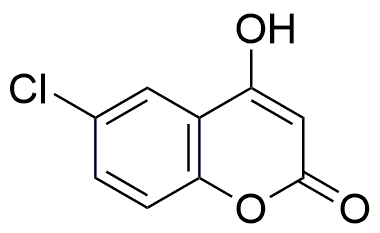6-Chloro-4-hydroxycoumarin is widely utilized in research focused on:
- Fluorescent Probes: This compound is often used in the development of fluorescent probes for biological imaging, enabling researchers to visualize cellular processes in real-time.
- Anticoagulant Research: It serves as a precursor in the synthesis of anticoagulant drugs, which are crucial for preventing blood clots in patients with cardiovascular diseases.
- Photodynamic Therapy: The compound is explored in photodynamic therapy applications for cancer treatment, where it can help in selectively targeting and destroying cancer cells when activated by light.
- Natural Product Synthesis: It plays a role in the synthesis of various natural products, contributing to the development of new pharmaceuticals and agrochemicals.
- Analytical Chemistry: This chemical is used in analytical methods for detecting and quantifying phenolic compounds in environmental samples, aiding in pollution monitoring and control.
Informations générales
Propriétés
Sécurité et réglementation
Applications
6-Chloro-4-hydroxycoumarin is widely utilized in research focused on:
- Fluorescent Probes: This compound is often used in the development of fluorescent probes for biological imaging, enabling researchers to visualize cellular processes in real-time.
- Anticoagulant Research: It serves as a precursor in the synthesis of anticoagulant drugs, which are crucial for preventing blood clots in patients with cardiovascular diseases.
- Photodynamic Therapy: The compound is explored in photodynamic therapy applications for cancer treatment, where it can help in selectively targeting and destroying cancer cells when activated by light.
- Natural Product Synthesis: It plays a role in the synthesis of various natural products, contributing to the development of new pharmaceuticals and agrochemicals.
- Analytical Chemistry: This chemical is used in analytical methods for detecting and quantifying phenolic compounds in environmental samples, aiding in pollution monitoring and control.
Documents
Fiches de données de sécurité (FDS)
La FDS fournit des informations de sécurité complètes sur la manipulation, le stockage et l’élimination du produit.
Spécifications du produit (PS)
Le PS fournit une description complète des propriétés du produit, notamment sa composition chimique, son état physique, sa pureté et les exigences de stockage. Il détaille également les plages de qualité acceptables et les applications prévues du produit.
Certificats d'analyse (COA)
Recherchez des certificats d'analyse (COA) en saisissant le numéro de lot du produit. Les numéros de lot et de lot se trouvent sur l'étiquette d'un produit, après les mots « Lot » ou « Lot de fabrication ».
Numéro de catalogue
Numéro de lot/série
Certificats d'origine (COO)
Ce certificat d'exploitation confirme le pays dans lequel le produit a été fabriqué, et détaille également les matériaux et composants utilisés et s'il est issu de sources naturelles, synthétiques ou autres sources spécifiques. Ce certificat peut être requis pour les douanes, le commerce et la conformité réglementaire.
Numéro de catalogue
Numéro de lot/série
Fiches de données de sécurité (FDS)
La FDS fournit des informations de sécurité complètes sur la manipulation, le stockage et l’élimination du produit.
DownloadSpécifications du produit (PS)
Le PS fournit une description complète des propriétés du produit, notamment sa composition chimique, son état physique, sa pureté et les exigences de stockage. Il détaille également les plages de qualité acceptables et les applications prévues du produit.
DownloadCertificats d'analyse (COA)
Recherchez des certificats d'analyse (COA) en saisissant le numéro de lot du produit. Les numéros de lot et de lot se trouvent sur l'étiquette d'un produit, après les mots « Lot » ou « Lot de fabrication ».
Numéro de catalogue
Numéro de lot/série
Certificats d'origine (COO)
Ce certificat d'exploitation confirme le pays dans lequel le produit a été fabriqué, et détaille également les matériaux et composants utilisés et s'il est issu de sources naturelles, synthétiques ou autres sources spécifiques. Ce certificat peut être requis pour les douanes, le commerce et la conformité réglementaire.


